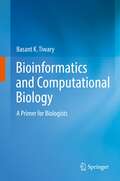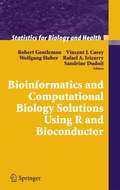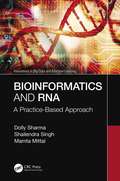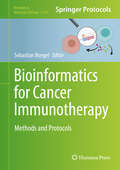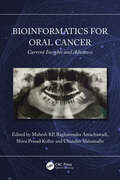- Table View
- List View
Bioinformatics and Biomedical Engineering: 11th International Conference, IWBBIO 2024, Meloneras, Gran Canaria, Spain, July 15–17, 2024, Proceedings, Part I (Lecture Notes in Computer Science #14848)
by Ignacio Rojas Francisco Ortuño Olga Valenzuela Fernando Rojas Luis Javier HerreraThis volume constitutes the proceedings of the 11th International Work-Conference on IWBBIO 2023, held in Gran Canaria, Spain, during July 15-17, 2022. The 54 full papers were carefully reviewed and selected from 148 submissions. They were organized in the following topical sections: Biomarker Identification, Biomedical Engineering, Biomedical Signal Analysis, E-Health.
Bioinformatics and Biomedical Engineering: 11th International Conference, IWBBIO 2024, Meloneras, Gran Canaria, Spain, July 15–17, 2024, Proceedings, Part II (Lecture Notes in Computer Science #14849)
by Ignacio Rojas Francisco Ortuño Olga Valenzuela Fernando Rojas Luis Javier HerreraThis volume constitutes the proceedings of the 11th International Work-Conference on IWBBIO 2023, held in Meloneras, Gran Canaria, Spain, during July 15-17, 2022. The 54 full papers were carefully reviewed and selected from 148 submissions. They were organized in the following topical sections: Healthcare and Diseases, Machine Learning in Bioinformatics, New Advances in Deep Learning in Bioinformatics and Biomedicine, Novel Methodologies and Applications in Bioinformatics and Biomedicine.
Bioinformatics and Biomedical Engineering: Third International Conference, Iwbbio 2015, Granada, Spain, April 15-17, 2015. Proceedings, Part I (Lecture Notes In Computer Science Ser. #9043)
by Ignacio Rojas Olga Valenzuela Fernando Rojas Luis Javier Herrera Francisco OrtuñoBioinformatics and Biomedical Engineering: 10th International Work-Conference, IWBBIO 2023, Meloneras, Gran Canaria, Spain, July 12–14, 2023, Proceedings, Part II (Lecture Notes in Computer Science #13920)
by Ignacio Rojas Olga Valenzuela Fernando Rojas Ruiz Luis Javier Herrera Francisco OrtuñoThis volume constitutes the proceedings of the 10th International Work-Conference on IWBBIO 2023, held in Meloneras, Gran Canaria, Spain, during July 12-14, 2022. The total of 79 papers presented in the proceedings, was carefully reviewed and selected from 209 submissions. The papers cove the latest ideas and realizations in the foundations, theory, models, and applications for interdisciplinary and multidisciplinary research encompassing disciplines of computer science, mathematics, statistics, biology, bioinformatics, and biomedicine.
Bioinformatics and Biomedical Engineering: 10th International Work-Conference, IWBBIO 2023, Meloneras, Gran Canaria, Spain, July 12–14, 2023, Proceedings, Part I (Lecture Notes in Computer Science #13919)
by Ignacio Rojas Olga Valenzuela Fernando Rojas Ruiz Luis Javier Herrera Francisco OrtuñoThis volume constitutes the proceedings of the 10th International Work-Conference on IWBBIO 2023, held in Meloneras, Gran Canaria, Spain, during July 12-14, 2022. The total of 79 papers presented in the proceedings, was carefully reviewed and selected from 209 submissions. The papers cove the latest ideas and realizations in the foundations, theory, models, and applications for interdisciplinary and multidisciplinary research encompassing disciplines of computer science, mathematics, statistics, biology, bioinformatics, and biomedicine.
Bioinformatics and Computational Biology: A Primer for Biologists
by Basant K. TiwaryThis textbook introduces fundamental concepts of bioinformatics and computational biology to the students and researchers in biology, medicine, veterinary science, agriculture, and bioengineering . The respective chapters provide detailed information on biological databases, sequence alignment, molecular evolution, next-generation sequencing, systems biology, and statistical computing using R. The book also presents a case-based discussion on clinical, veterinary, agricultural bioinformatics, and computational bioengineering for application-based learning in the respective fields. Further, it offers readers guidance on reconstructing and analysing biological networks and highlights computational methods used in systems medicine and genome-wide association mapping of diseases. Given its scope, this textbook offers an essential introductory book on bioinformatics and computational biology for undergraduate and graduate students in the life sciences, botany, zoology, physiology, biotechnology, bioinformatics, and genomic science as well as systems biology, bioengineering and the agricultural, and veterinary sciences.
Bioinformatics and Computational Biology Solutions Using R and Bioconductor (Statistics for Biology and Health)
by Robert Gentleman Vincent Carey Wolfgang Huber Rafael Irizarry Sandrine DudoitFull four-color book. Some of the editors created the Bioconductor project and Robert Gentleman is one of the two originators of R. All methods are illustrated with publicly available data, and a major section of the book is devoted to fully worked case studies. Code underlying all of the computations that are shown is made available on a companion website, and readers can reproduce every number, figure, and table on their own computers.
Bioinformatics and Drug Discovery (Methods in Molecular Biology #316)
by Richard S. LarsonA collection of readily reproducible bioinformatic methods to advance the drug discovery process from gene identification to protein modeling to the identification of specific drug candidates. The authors demonstrate these techniques, including microarray analysis, the analysis of genes as potential drug targets, virtual screening and in silico protein design, and cheminformatics, in a variety of practical situations. Because these technologies are still emergent, each chapter contains an extended introduction that explains the theory and application of the technology and techniques described.
Bioinformatics and Drug Discovery (Methods in Molecular Biology #910)
by Richard S. LarsonRecent advances in drug discovery have been rapid. The second edition of Bioinformatics and Drug Discovery has been completely updated to include topics that range from new technologies in target identification, genomic analysis, cheminformatics, protein analysis, and network or pathway analysis. Each chapter provides an extended introduction that describes the theory and application of the technology. In the second part of each chapter, detailed procedures related to the use of these technologies and software have been incorporated. Written in the highly successful Methods in Molecular Biology™ series format, the chapters include the kind of detailed description and implementation advice that is crucial for getting optimal results in the laboratory. Thorough and intuitive, Bioinformatics and Drug Discovery, Second Edition seeks to aid scientists in the further study of the rapidly expanding field of drug discovery.
Bioinformatics and Drug Discovery (Methods in Molecular Biology #1939)
by Richard S. Larson Tudor I. OpreaThis third edition volume expands on the previous editions with new topics that cover drug discovery through translational bioinformatics, informatics, clinical research informatics, as well as clinical informatics. The chapters discuss new methods to study target identification, genome analysis, cheminformatics, protein analysis, and text mining. Written in the highly successful Methods in Molecular Biology series format, chapters include introductions to their respective topics, lists of the necessary materials, software workflows, reagents and on-line resources, together with step-by-step, readily reproducible laboratory and computational protocols, and tips on troubleshooting and avoiding known pitfalls.Cutting-edge and thorough, Bioinformatics and Drug Discovery, Third Edition is a valuable resource for anyone interested in drug design, including academicians (biologists, informaticists and data scientists, chemists, and biochemists), clinicians, and pharmaceutical scientists.
Bioinformatics and Genome Analysis (Ernst Schering Foundation Symposium Proceedings #38)
by B. Weiss H. Seidel H. W. MewesBioinformatics and Human Genomics Research
by Diego A. ForeroAdvances in high-throughput biological methods have led to the publication of a large number of genome-wide studies in human and animal models. In this context, recent tools from bioinformatics and computational biology have been fundamental for the analysis of these genomic studies. The book Bioinformatics and Human Genomics Research provides updated and comprehensive information about multiple approaches of the application of bioinformatic tools to research in human genomics. It covers strategies analysis of genome-wide association studies, genome-wideexpression studies and genome-wide DNA methylation, among other topics. It provides interesting strategies for data mining in human genomics, network analysis, prediction of binding sites for miRNAs and transcription factors, among other themes. Experts from all around the world in bioinformatics and human genomics have contributed chapters in this book. Readers will find this book as quite useful for their in silico explorations, which would contribute to a better and deeper understanding of multiple biological processes and of pathophysiology of many human diseases.
Bioinformatics and Human Genomics Research
by Diego A. ForeroAdvances in high-throughput biological methods have led to the publication of a large number of genome-wide studies in human and animal models. In this context, recent tools from bioinformatics and computational biology have been fundamental for the analysis of these genomic studies. The book Bioinformatics and Human Genomics Research provides updated and comprehensive information about multiple approaches of the application of bioinformatic tools to research in human genomics. It covers strategies analysis of genome-wide association studies, genome-wideexpression studies and genome-wide DNA methylation, among other topics. It provides interesting strategies for data mining in human genomics, network analysis, prediction of binding sites for miRNAs and transcription factors, among other themes. Experts from all around the world in bioinformatics and human genomics have contributed chapters in this book. Readers will find this book as quite useful for their in silico explorations, which would contribute to a better and deeper understanding of multiple biological processes and of pathophysiology of many human diseases.
Bioinformatics and RNA: A Practice-Based Approach (Innovations in Big Data and Machine Learning)
by Dolly Sharma Shailendra Singh Mamta MittalThis book offers a unique balance between a basic introductory knowledge of bioinformatics and a detailed study of algorithmic techniques. Bioinformatics and RNA: A Practice-Based Approach is a complete guide on the fundamental concepts, applications, algorithms, protocols, new trends, challenges, and research results in the area of bioinformatics and RNA.The book offers a broad introduction to the explosively growing new discipline of bioinformatics. It covers theoretical topics along with computational algorithms. It explores RNA bioinformatics, which contribute to therapeutics and drug discovery. Implementation of algorithms in a DotNet Framework with code and complete insight on the state-of-the-art and recent advancements are presented in detail. The book targets both novice readers as well as practitioners in the field. FEATURES Offers a broad introduction to the explosively growing new discipline of bioinformatics Covers theoretical topics and computational algorithms Explores RNA bioinformatics to unleash the potential from therapeutics to drug discovery Discusses implementation of algorithms in DotNet Frameworks with code Presents insights into the state of the art and recent advancements in bioinformatics The book is useful to undergraduate students with engineering, science, mathematics, or biology backgrounds. Researchers will be equally interested.
Bioinformatics and RNA: A Practice-Based Approach (Innovations in Big Data and Machine Learning)
by Dolly Sharma Shailendra Singh Mamta MittalThis book offers a unique balance between a basic introductory knowledge of bioinformatics and a detailed study of algorithmic techniques. Bioinformatics and RNA: A Practice-Based Approach is a complete guide on the fundamental concepts, applications, algorithms, protocols, new trends, challenges, and research results in the area of bioinformatics and RNA.The book offers a broad introduction to the explosively growing new discipline of bioinformatics. It covers theoretical topics along with computational algorithms. It explores RNA bioinformatics, which contribute to therapeutics and drug discovery. Implementation of algorithms in a DotNet Framework with code and complete insight on the state-of-the-art and recent advancements are presented in detail. The book targets both novice readers as well as practitioners in the field. FEATURES Offers a broad introduction to the explosively growing new discipline of bioinformatics Covers theoretical topics and computational algorithms Explores RNA bioinformatics to unleash the potential from therapeutics to drug discovery Discusses implementation of algorithms in DotNet Frameworks with code Presents insights into the state of the art and recent advancements in bioinformatics The book is useful to undergraduate students with engineering, science, mathematics, or biology backgrounds. Researchers will be equally interested.
Bioinformatics Biocomputing and Perl: An Introduction to Bioinformatics Computing Skills and Practice
by Michael Moorhouse Paul BarryBioinformatics, Biocomputing and Perl presents a modern introduction to bioinformatics computing skills and practice. Structuring its presentation around four main areas of study, this book covers the skills vital to the day-to-day activities of today’s bioinformatician. Each chapter contains a series of maxims designed to highlight key points and there are exercises to supplement and cement the introduced material. Working with Perl presents an extended tutorial introduction to programming through Perl, the premier programming technology of the bioinformatics community. Even though no previous programming experience is assumed, completing the tutorial equips the reader with the ability to produce powerful custom programs with ease. Working with Data applies the programming skills acquired to processing a variety of bioinformatics data. In addition to advice on working with important data stores such as the Protein DataBank, SWISS-PROT, EMBL and the GenBank, considerable discussion is devoted to using bioinformatics data to populate relational database systems. The popular MySQL database is used in all examples. Working with the Web presents a discussion of the Web-based technologies that allow the bioinformatics researcher to publish both data and applications on the Internet. Working with Applications shifts gear from creating custom programs to using them. The tools described include Clustal-W, EMBOSS, STRIDE, BLAST and Xmgrace. An introduction to the important Bioperl Project concludes this chapter and rounds off the book.
Bioinformatics for agriculture: High-throughput approaches
by Atul Kumar Upadhyay R Sowdhamini Virupaksh U. PatilThis book illustrates the importance and significance of bioinformatics in the field of agriculture. It first introduces the basic concepts of bioinformatics, such as homologous sequence and gene function analyses, determination of protein structures, and discusses machine learning applications for an in-depth understanding of the desired genes and proteins based on commonly used bioinformatics software and tools, e.g. BLAST, molecular modelling, molecular-docking and simulations, protein-protein and domain-domain interactions. The book also describes recent advances in the high-throughput analysis of whole genome and transcriptome using next-generation sequencing platforms, and functional proteome studies. It also examines the role of computational biology in understanding and improving the nutrient quality and yield of crops. Lastly, the book explores a comprehensive list of applications of bioinformatics to improve plant yield, biomass, and health, and the challenges involved.
Bioinformatics for Cancer Immunotherapy: Methods and Protocols (Methods in Molecular Biology #2120)
by Sebastian BoegelThis volume focuses on a variety of in silico protocols of the latest bioinformatics tools and computational pipelines developed for neo-antigen identification and immune cell analysis from high-throughput sequencing data for cancer immunotherapy. The chapters in this book cover topics that discuss the two emerging concepts in recognition of tumor cells using endogenous T cells: cancer vaccines against neo-antigens presented on HLA class I and II alleles, and checkpoint inhibitors. Written in the highly successful Methods in Molecular Biology series format, chapters include introductions to their respective topics, lists of the necessary materials and reagents, step-by-step, readily reproducible laboratory protocols, and tips on troubleshooting and avoiding known pitfalls.Cutting-edge and authoritative, Bioinformatics for Cancer Immunotherapy: Methods and Protocols is a valuable research tool for any scientist and researcher interested in learning more about this exciting and developing field.
Bioinformatics for Diagnosis, Prognosis and Treatment of Complex Diseases (Translational Bioinformatics #4)
by Bairong ShenThe book introduces the bioinformatics tools, databases and strategies for the translational research, focuses on the biomarker discovery based on integrative data analysis and systems biological network reconstruction. With the coming of personal genomics era, the biomedical data will be accumulated fast and then it will become reality for the personalized and accurate diagnosis, prognosis and treatment of complex diseases. The book covers both state of the art of bioinformatics methodologies and the examples for the identification of simple or network biomarkers. In addition, bioinformatics software tools and scripts are provided to the practical application in the study of complex diseases. The present state, the future challenges and perspectives were discussed. The book is written for biologists, biomedical informatics scientists and clinicians, etc. Dr. Bairong Shen is Professor and Director of Center for Systems Biology, Soochow University; he is also Director of Taicang Center for Translational Bioinformatics.
Bioinformatics for DNA Sequence Analysis (Methods in Molecular Biology #537)
by David PosadaThe recent accumulation of information from genomes, including their sequences, has resultednotonlyinnewattemptstoansweroldquestionsandsolvelongstandingissues inbiology,butalsointheformulationofnovelhypothesesthatarisepreciselyfromthis wealth of data. The storage, processing, description, transmission, connection, and analysis of these data has prompted bioinformatics to become one the most relevant applied sciences for this new century, walking hand-in-hand with modern molecular biology and clearly impacting areas like biotechnology and biomedicine. Bioinformatics skills have now become essential for many scientists working with DNA sequences. With this idea in mind, this book aims to provide practical guidance andtroubleshootingadviceforthecomputationalanalysisofDNAsequences,covering a range of issues and methods that unveil the multitude of applications and relevance that Bioinformatics has today. The analysis of protein sequences has been purposely excludedtogainfocus.Individualbookchaptersareorientedtowardthedescriptionof theuseofspecificbioinformaticstools,accompaniedbypracticalexamples,adiscussion on the interpretation of results, and specific comments on strengths and limitations of the methods and tools. In a sense, chapters could be seen as enriched task-oriented manuals that will direct the reader in completing specific bioinformatics analyses. The target audience for this book is biochemists, and molecular and evolutionary biologiststhatwanttolearnhowtoanalyzeDNAsequencesinasimplebutmeaningful fashion. Readers do not need a special background in statistics, mathematics, or computer science, just a basic knowledge of molecular biology and genetics. All the tools described in the book are free and all of them can be downloaded or accessed throughtheweb.Mostchapterscouldbeusedforpracticaladvancedundergraduateor graduate-level courses in bioinformatics and molecular evolution.
Bioinformatics for Glycobiology and Glycomics: An Introduction
by Claus-Wilhelm Von Der Lieth Thomas Luetteke Martin FrankThis book is the first to be dedicated to the bioinformatics of carbohydrates and glycoproteins. It provides an introduction to this emerging field of science both for the experimentalist working in glycobiology and glycomics, and also for the computer scientist looking for background information for the development of highly sophisticated algorithmic approaches. The book provides an overview of the state-of-the-art in the field, with reviews on databases, and the tools in use for analysis, interpretation, and prediction of the structures of complex carbohydrates, and demonstrates the value of bioinformatics for glycobiology. The availability of comprehensive databases and corresponding bioinformatics tools, to access and analyse the large amounts of experimental data relating to the structure of carbohydrates, will be a prerequisite for the success of the large-scale glycomics projects that aim to decipher new, so far unknown, biological functions of glycans. Efficient bioinformatics descriptions and tools can considerably enhance the efficiency of glycomics research, in terms of data quality, analysis and experimental costs. For a complete understanding of the molecular processes in which carbohydrates are involved, such as protein–carbohydrate interactions and the impact of glycosylation on protein function, knowledge of the 3D structure of the carbohydrate, the protein–carbohydrate complex, or the glycoprotein is often indispensable. This book provides a thorough introduction into methods used for conformational analysis of carbohydrates. Key features: Describes bioinformatic approaches to handle carbohydrate-active enzymes and glycosylation. Provides an overview on bioinformatics tools that facilitate analysis of carbohydrate structures. Gives introduction into molecular modelling of carbohydrate 3D structure and carbohydrates contained in the Protein Databank. Assumes only a basic knowledge of biology and bioinformatics.
Bioinformatics for High Throughput Sequencing
by Naiara Rodríguez-Ezpeleta, Michael Hackenberg and Ana M. M. AransayNext generation sequencing is revolutionizing molecular biology. Owing to this new technology it is now possible to carry out a panoply of experiments at an unprecedented low cost and high speed. These go from sequencing whole genomes, transcriptomes and small non-coding RNAs to description of methylated regions, identification protein – DNA interaction sites and detection of structural variation. The generation of gigabases of sequence information for each of this huge bandwidth of applications in just a few days makes the development of bioinformatics applications for next generation sequencing data analysis as urgent as challenging.
Bioinformatics for Immunomics (Immunomics Reviews: #3)
by Darren R. Flower Matthew N. Davies Shoba RanganathanLike many words, the term “immunomics” equates to different ideas contingent on context. For a brief span, immunomics meant the study of the Immunome, of which there were, in turn, several different definitions. A now largely defunct meaning rendered the Immunome as the set of antigenic peptides or immunogenic proteins within a single microorganism – be that virus, bacteria, fungus, or parasite – or microbial population, or antigenic or allergenic proteins and peptides derived from the environment as a whole, containing also proteins from eukaryotic sources. However, times have changed and the meaning of immunomics has also changed. Other newer definitions of the Immunome have come to focus on the plethora of immunological receptors and accessory molecules that comprise the host immune arsenal. Today, Immunomics or immunogenomics is now most often used as a synonym for high-throughput genome-based immunology. This is the study of aspects of the immune system using high-throughput techniques within a conc- tual landscape borne of both clinical and biophysical thinking.
Bioinformatics for Oral Cancer: Current Insights and Advances
by Raghavendra Amachawadi Shiva Prasad Kollur Chandan Shivamallu Mahesh KpAmid the rising global concern of oral cancer, this book provides a compelling exploration of the intricate oral cavity, focused on shedding light on early diagnosis and addressing outdated paradigms, it delves into the persistent challenges of oral premalignant lesions. Tailored for both beginners and researchers, its six chapters encompass the spectrum of genome sequencing, diagnostic biomarkers, gene expression, and more. Discover a fusion of basic and clinical sciences, aiming to invigorate the study of bioinformatics and oral cancer, and ultimately improve survival rates.Bioinformatics for Oral Cancer: Current Insights and Advances serves as a comprehensive guide, offering a deep dive into the multifaceted landscape of oral cancer research and bioinformatics. Within its pages, readers will uncover a wealth of knowledge, starting with foundational chapters introducing bioinformatics and establishing the backdrop of oral cancer. The book then progresses into the realm of diagnostic biomarkers, revealing cutting-edge methodologies for their identification in the context of oral cancer. The book’s keen focus extends to gene expression profiles and the intricacies of gene sequencing in the context of oral cancer progression. By systematically unravelling these critical aspects, the book bridges the gap between basic and clinical sciences, equipping readers with a holistic understanding of bioinformatics’ pivotal role in enhancing our grasp of oral cancer’s complexities.By deciphering the enigmatic landscape of oral premalignant lesions, the book equips clinicians and researchers with tools to predict malignant potentials. Its meticulous exploration of gene expression profiles and sequencing promises to reshape early detection strategies, propelling the field towards improved diagnosis and treatment outcomes.
Bioinformatics for Oral Cancer: Current Insights and Advances
Amid the rising global concern of oral cancer, this book provides a compelling exploration of the intricate oral cavity, focused on shedding light on early diagnosis and addressing outdated paradigms, it delves into the persistent challenges of oral premalignant lesions. Tailored for both beginners and researchers, its six chapters encompass the spectrum of genome sequencing, diagnostic biomarkers, gene expression, and more. Discover a fusion of basic and clinical sciences, aiming to invigorate the study of bioinformatics and oral cancer, and ultimately improve survival rates.Bioinformatics for Oral Cancer: Current Insights and Advances serves as a comprehensive guide, offering a deep dive into the multifaceted landscape of oral cancer research and bioinformatics. Within its pages, readers will uncover a wealth of knowledge, starting with foundational chapters introducing bioinformatics and establishing the backdrop of oral cancer. The book then progresses into the realm of diagnostic biomarkers, revealing cutting-edge methodologies for their identification in the context of oral cancer. The book’s keen focus extends to gene expression profiles and the intricacies of gene sequencing in the context of oral cancer progression. By systematically unravelling these critical aspects, the book bridges the gap between basic and clinical sciences, equipping readers with a holistic understanding of bioinformatics’ pivotal role in enhancing our grasp of oral cancer’s complexities.By deciphering the enigmatic landscape of oral premalignant lesions, the book equips clinicians and researchers with tools to predict malignant potentials. Its meticulous exploration of gene expression profiles and sequencing promises to reshape early detection strategies, propelling the field towards improved diagnosis and treatment outcomes.





